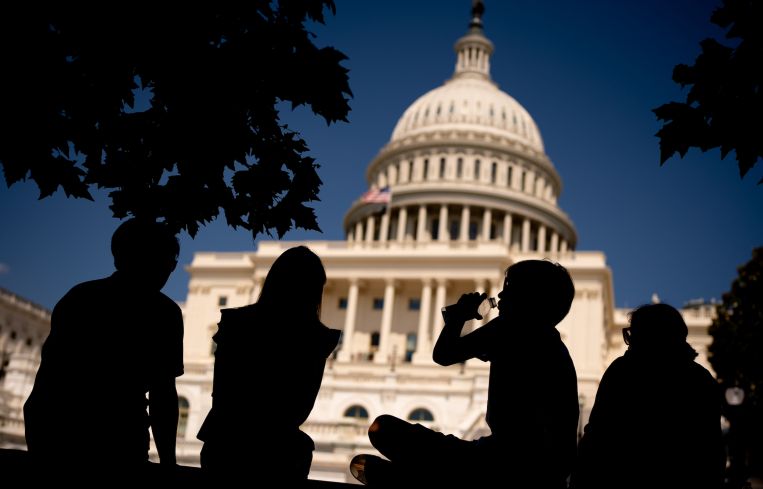Sunday Summary: Has D.C. Office Successfully Dodged DOGE?
By The Editors August 10, 2025 9:00 am
reprints
There’s no shortage of political shenanigans coming out of our nation’s capital, but when Elon Musk went on his berserk, DOGE-fueled rampage at the beginning of the year, many in Washington, D.C., braced for the worst.
An already battered market was losing its best tenant (the U.S. government). How would the town survive?
Of course, Musk is now back at Tesla (and being well compensated for it) and out of the good graces of the Trump administration (even Musk’s famously despised “five things” email was rolled back). But what of all the cuts he made and leases he canceled at the beginning of the year?
Now that we’ve had a few months to digest it, the results are…. Not quite as bad as some had feared.
This is not to suggest that things are good in the D.C. office arena. Overall vacancy remains dizzyingly high at 22.6 percent, according to CBRE. Some 5.6 million square feet of office space has been dubbed “zombie” space (technically on the market, but unrentable).
That being said, vacancy at newer offices is actually at record lows. A deal to bring the NFL’s Washington Commanders back into the District, too, looks tantalizingly close. And, while there was quite a bit of strum und drang from the likes of Musk et al, the actual number of leases cut in the District stands only at 13.
Of course, some of these footprints were massive, like the U.S. Department of Labor’s 845,389-square-foot lease at 2 Massachusetts Avenue NE… but even the supposed $7.1 million in savings that DOGE initially claimed was overstated. (The department’s lease was set to expire on May 14, and DOGE’s website now says it didn’t save a single dollar on walking out on that property.)
And, while the cuts have been damaging and the prospects of future cuts remain real, many in D.C.’s real estate scene have also comforted themselves with the fact that there’s only so much that can be done to diminish the government’s footprint in a government-centric city.
“Government’s not going anywhere, and there’ll be users of office space that want to be in close proximity,” said CBRE’s Brad Wilner. “The challenge is going to be finding the appropriate space and creating this high-end segment of the market where the demand feels insatiable. People are willing to pay for nice product. It’s a matter of being able to deliver nice product.”
Meanwhile, in earnings land
Another week, another raft of earnings calls. And (just like last week) the news was positive.
Starwood Property Trust exceeded analyst expectations thanks to a 66 percent uptick in net income from last quarter to $129.8 million.
JLL was able to tell the doubters and haters on Wall Street to take a long walk off a short pier, thanks to the fifth straight quarter of double-digit revenue growth (they reported $6.25 billion, up 10 percent from the second quarter in 2024 and $300 million more than analysts expected).
Likewise, Cushman & Wakefield beat earnings estimates and saw revenue from its capital markets team rise a healthy 27 percent. (Speaking of C&W, did you hear that they’re moving offices? We did.)
Brookfield boasted a huge jump in net income of $1.1 billion from the $215 million they reported last quarter and the $285 million from the second quarter of 2024. (And they’ve already got good news for next quarter — last week they rented 44,000 square feet to the New York State Office of General Services at 1 New York Plaza.)
Howard Hughes Holdings is thinking about diversification — and investing some $900 million to do it. (One thing they’re planning on doing is purchasing an insurance company.)
Things remained relatively steady for Equity Residential despite leadership changes and nerves about some of the multifamily markets where they currently have holdings.
Vornado Realty Trust had a damn good call (thank you, 770 Broadway); and, despite their worries about tariffs, Simon Property Group reported a net income of $556.1 million this past quarter, which is significantly better than the $413.7 million they reported in the first quarter. (Maybe now we get a sense of why Bain Capital and 11North Partners plunked down $395 million for a 10-retail center portfolio in Florida and South Carolina from PGIM Real Estate.)
Feeling nervous?
Of course, some “big picture” worries went unspoken on these calls. But a few were voiced.
It’s no secret that mayoral favorite Zorhan Mamdani is not everyone’s first pick.
“If Mamdani wins, expect the REITs to slow-roll any fresh New York City buys for office or multifamily properties,” said Lev Mavashev of Alpha Realty. “Most will be targeting more pro-business-friendly markets for their acquisitions. Local private investors will still be active, but the REITs will most likely sit it out.”
There’s some truth in that.
Yes, we saw deals outside the city. For instance, CoreWeave purchased 27 acres of land and a research and development building in the Northeast Science & Technology Center (NEST) campus in Kenilworth, N.J., for $322 million.
Also in the Garden State Namdar Group got construction financing to the tune of $358 million for 1,126 units of housing at 29 Van Reipen Avenue and 612 Pavonia Avenue in Journal Square in Jersey City.
And the big mamou of the week was the $1.6 billion the Bethesda, Md.-based Elme Communities got from Cortland for 19 multifamily properties (most of which are in the Washington, D.C., area).
However, there’s still plenty of activity in New York.
There have been deals like Douglaston Development and Corebridge Real Estate Investors bagging $287 million from KKR Real Estate Credit for their Williamsburg apartment complex, and TF Cornerstone making plans to convert the 32-story office tower at 135 East 57th Street into apartments. Plus, the New York City Housing Authority tapped Related Companies to construct 217 units of housing at 401 West 19th Street in Chelsea.
And, while some have been actively trying to help Eric Adams, like SL Green’s Marc Holliday (BTW — take a look at our profile of SL Green’s CIO, Harrison Sitomer), others have been more sanguine about who eventually wins.
“I think it’s entirely likely that Mamdani will be elected,” BXP’s Hilary Spann told CO in our cover story last week, “but he will have to operate in an ecosystem where the state government has a lot of control over some of what he can do. … I think we, and the clients that we do these developments on behalf of, believe that New York will succeed.”
That’s as good a note as any to end on. But, if you’d like some additional Sunday reading and want to imagine yourself away from the summer heat, check out our story about TruAmerica’s Matt Ferrari’s intrepid climb up Mount Everest.
See you next week!



